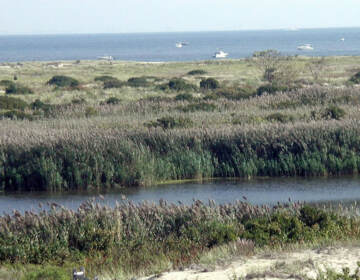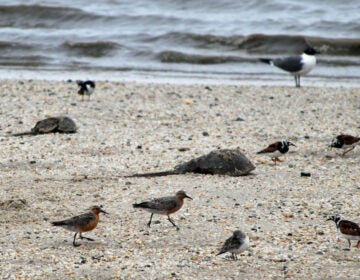Barnegat Bay marshes help keep water clean
Much of the tidal marshland in New Jersey’s Barnegat Bay has been destroyed, but the remaining 26,000 acres provide important filtering for the ecosystem.

A swan swims in Barnegat Bay in Toms River, N.J. (AP Photo/Wayne Parry)
Much of the tidal marshland in New Jersey’s Barnegat Bay has been destroyed, but two new studies show the remaining 26,000 acres are providing important filtration of the ecosystem.
Storm water runoff and fertilizer from farms and lawns end up in the bay. They carry nutrients, such as nitrogen and phosphorous, which pollute the water and can make it unusable for marine life and humans.
But in Barnegat Bay, the tidal marshes serve as a natural filter. One study led by David Velinsky, head of the Department of Biodiversity, Earth and Environmental Science at Drexel University, shows that the marshes bury about 80 percent of nitrogen and 50 percent of phosphorous.
A second study shows that marshes remove about 30 percent of nitrogen through denitrification, a microbial process that converts nitrate into nitrogen gas, which leaves the water. The numbers have high uncertainty, but “what I come away with, what I usually say is, ‘a substantial amount of nutrients are removed through the wetland,’ ” Velinsky said.
Overall, in the U.S., wetlands remove about a fifth of the nitrogen that washes off the land toward bodies of water.
Without the wetlands, keeping Barnegat Bay clean would be a lot more expensive, Velinsky said. It would require more preventive measures to keep nutrients from washing into the bay and more wastewater-treatment facilities.
Since the 1940s, development has destroyed much of the marsh on New Jersey’s coast, and the population has surged.
“Now we have a lot of people down there, the economy is great, but we also need to protect the wetlands,” Velinsky said. “In order to protect the water quality and the fishing and the clamming and so on that people use for recreation. I mean, you’re not going to want to sail your boat down there if the water is clouded up by a lot of algae.”
Another problem researchers are watching is the rising sea level. Sediment washing into the wetlands helps maintain and build the marshes, but seas in that area are rising faster than the rate of marsh accretion, which means large sections could drown within decades.
WHYY is your source for fact-based, in-depth journalism and information. As a nonprofit organization, we rely on financial support from readers like you. Please give today.




